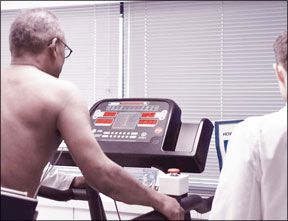A recent study of cardiac rehabilitation patients found that those who walked at a slower pace, but for longer periods of time, saw better results than rehab patients who walked shorter distances at a brisker pace. The study, published in the May 11 issue of Circulation: Journal of the American Heart Association, noted that moderate-pace walking for 45 to 60 minutes, five to six days per week, was considered a high-calorie-burning exercise and would be especially valuable for cardiac rehab patients who are overweight. Mike Crawford, MS, manager of the Cleveland Clinic Cardiac Rehabilitation program, says hes not surprised by the studys findings. That approach has been in place at Cleveland Clinic for some time. "People who have risk factors for coronary disease tend to have better results with lower-intensity, longer-endurance exercise," Crawford says. A typical cardiac rehab patient might work up to an exercise level that is 60 to 70 percent of his or her maximum activity level, Crawford explains, though some individuals, such as heart failure patients, might work at 50 percent.
To continue reading this article or issue you must be a paid subscriber.
Sign in






